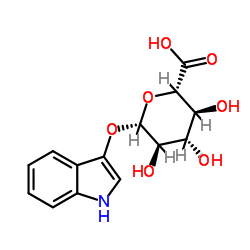Indoxyl-beta-D-glucuronide and 3-indoxyl sulfate in plasma of hemodialysis patients.
S Agatsuma, H Sekino, H Watanabe
Index: Clin. Nephrol. 45(4) , 250-6, (1996)
Full Text: HTML
Abstract
The content of indoxyl-beta-D-glucuronide, which has been found in patients' plasma as a new indicator of renal failure, logarithmically correlated with that of 3-indoxyl sulfate (indican) in the plasma of hemodialysis patients, showing another weak correlation with beta(2)-microglobulin content. The content ratio of indoxyl-beta-D-glucuronide to 3-indoxyl sulfate (IG/IS) gradually increased depending on the duration of hemodialysis treatment. Indoxyl-beta-D-glucuronide could be easily dialyzed in the hemodialysis treatment, in contrast to hardly dialyzable 3-indoxyl sulfate which bound to plasma proteins. Therefore, glucuronide conjugation in indole excretion is favorable for hemodialysis patients in that it eliminates indoxyl compounds in blood by hemodialysis.
Related Compounds
| Structure | Name/CAS No. | Molecular Formula | Articles |
|---|---|---|---|
 |
1H-Indol-3-yl β-D-glucopyranosiduronic acid
CAS:35804-66-1 |
C14H15NO7 |
|
Rapid detection of Escherichia coli in urine samples by a ne...
1989-04-01 [J. Clin. Microbiol. 27 , 778-779, (1989)] |
|
Accumulation of indoxyl-beta-D-glucuronide in uremic serum: ...
1996-01-01 [Nephron 74(1) , 72-8, (1996)] |
|
[Evaluation of a new disk containing indoxyl-beta-D-glucuron...
1996-09-01 [Rinsho Byori. 44(9) , 895-8, (1996)] |
|
Rapid and specific detection of hydroxyl radical using an ul...
2001-05-01 [J. Agric. Food Chem. 49(5) , 2137-41, (2001)] |
|
Comparison of the recoveries of Escherichia coli and total c...
1996-01-01 [Appl. Environ. Microbiol. 62(1) , 203-8, (1996)] |